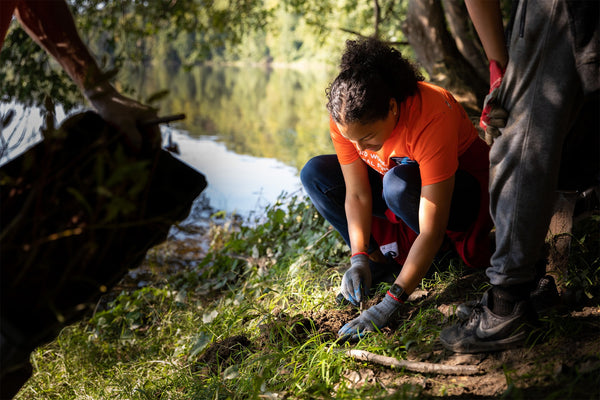What is Environmental Justice?
In our work, we talk about environmental justice often in relation to the powerful social impact of our projects. But what is environmental justice and how does it relate to planting trees? The environmental justice movement is not new, but public awareness of it in an age of accelerating and inequitable climate change impacts is growing. With this increased awareness and attention comes the danger of unintentionally diluting a powerful, historic social movement into yet another environmental buzzword.
So before we dive into the environmental justice principles and how tree planting helps, let’s get really clear on the environmental justice definition. When talking about environmental justice, it’s important first to acknowledge the very real impacts of environmental racism — which was defined by Reverend Benjamin E. Chavis, Jr., Ex-Chairman of the NAACP as “racial discrimination in environmental policy-making, enforcement of regulations and laws, and targeting of communities of color for toxic waste disposal and siting of polluting industries.” This discrimination has lead to a disproportionate impact on communities of color from environmental hazards like air pollution, toxic waste, radiation, pesticides, heavy metals, extreme temperatures, and more — as well as real and documented effects this has on health, learning, quality of life, and more.
Environmental justice is a response to the profound and long-lasting effects of environmental racism. It extends far beyond the concept of environmental equity (the ideal of equal treatment and access for everyone in regards to environmental statutes, regulations, and practices) to encompass the right to “a safe, healthy, productive, and sustainable environment for all.” Under this definition, the concept of environment includes the “ecological (biological), physical (natural and built), social, political, aesthetic, and economic environments.” The ability to exercise this right requires conditions where “individual and group identities, needs, and dignities are preserved, fulfilled, and respected in a way that provides for self actualization and personal and community empowerment.”
The 17 Principles of Environmental Justice
Drafted and adopted by delegates to the First National People of Color Environmental Leadership Summit held in October of 1991, these 17 principles of Environmental Justice have defined and guided the growing grassroots movement for environmental justice.

1. Environmental Justice affirms the sacredness of Mother Earth, ecological unity and the interdependence of all species, and the right to be free from ecological destruction.

2. Environmental Justice demands that public policy be based on mutual respect and justice for all peoples, free from any form of discrimination or bias.

3. Environmental Justice mandates the right to ethical, balanced and responsible uses of land and renewable resources in the interest of a sustainable planet for humans and other living things.

4. Environmental Justice calls for universal protection from nuclear testing, extraction, production and disposal of toxic/hazardous wastes and poisons and nuclear testing that threaten the fundamental right to clean air, land, water, and food.

5. Environmental Justice affirms the fundamental right to political, economic, cultural and environmental self-determination of all peoples.

6. Environmental Justice demands the cessation of the production of all toxins, hazardous wastes, and radioactive materials, and that all past and current producers be held strictly accountable to the people for detoxification and the containment at the point of production.

7. Environmental Justice demands the right to participate as equal partners at every level of decision-making, including needs assessment, planning, implementation, enforcement and evaluation.

8. Environmental Justice affirms the right of all workers to a safe and healthy work environment without being forced to choose between an unsafe livelihood and unemployment. It also affirms the right of those who work at home to be free from environmental hazards.

9. Environmental Justice protects the right of victims of environmental injustice to receive full compensation and reparations for damages as well as quality health care.

10. Environmental Justice considers governmental acts of environmental injustice a violation of international law, the Universal Declaration On Human Rights, and the United Nations Convention on Genocide.

11. Environmental Justice must recognize a special legal and natural relationship of Native Peoples to the U.S. government through treaties, agreements, compacts, and covenants affirming sovereignty and self-determination.

12. Environmental Justice affirms the need for urban and rural ecological policies to clean up and rebuild our cities and rural areas in balance with nature, honoring the cultural integrity of all our communities, and provided fair access for all to the full range of resources.

13. Environmental Justice calls for the strict enforcement of principles of informed consent, and a halt to the testing of experimental reproductive and medical procedures and vaccinations on people of color.

14. Environmental Justice opposes the destructive operations of multi-national corporations.

15. Environmental Justice opposes military occupation, repression and exploitation of lands, peoples and cultures, and other life forms.
